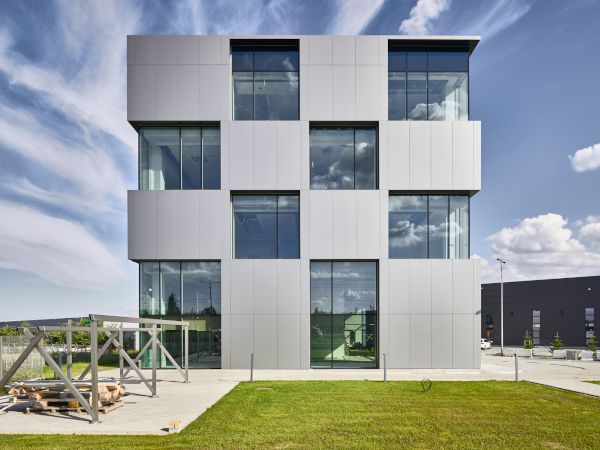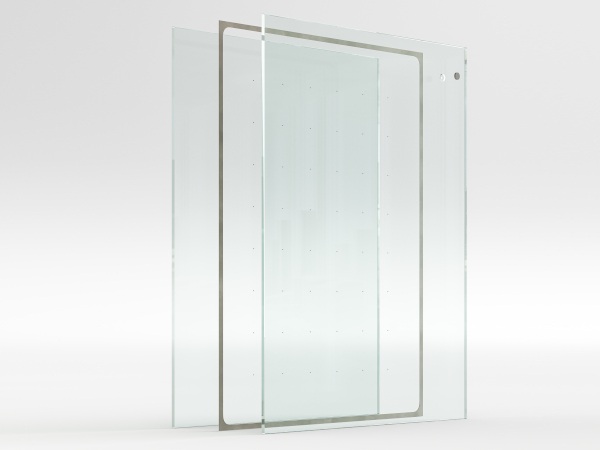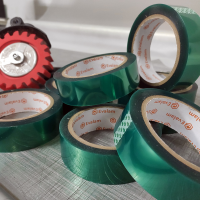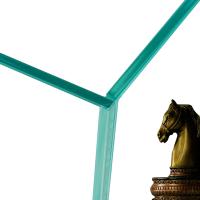Date: 19 December 2001
Security glass must contain the original attack – bullet, bandit or blast – and is further required to minimize "spalling" – glass shrapnel that erupts from the 'protect' face of the screen, causing damage and lacerations to anyone in the way.Spallshield© composite, a DuPont Advanced Glazing Product based on Butacite© PVB, completely eliminates spalling when applied to the protect face of the glazing. These zero-spall constructions also have the additional benefit of being lighter and thinner than conventional glazing.
Spallshield© is a composite film of PVB/PET, factory-laminated to the protect face of the glass. The PVB functions as an energy-absorbing, adhesive layer while the PET, with an abrasion resistant hardcoat, present a tough, optically flat external face. A typical construction would be PVB (0.76mm/PET (0.19mm) – adding just 0.95mm to the glass thickness. The finished laminates display a range of basic properties essential to meeting the needs of the primary glass market:
-optically pure
-non-yellowing and haze-free
-self-extinguishing under ANSI Z-26.1-83 Test 24
-abrasion resistant
-resistant to aggressive organic solvents
Spallshield© laminates can be glazed using conventional sealing and framing systems taking care that the selected design of glass/frame/seal is matched to the threat level.
Bullet resistant glazing
For people who handle money in banks, kiosks and ticket offices, it is now unfortunately no longer just a possibility but a probability that they will face armed threat at some time. Most bullet-resistant glasses are multi-layered glass/PVB laminates, often with an inboard polycarbonate layer. The key needs of minimum thickness and low weight must be balanced against the ability to stop bullets with no danger to the person on the protect side of the glass.
When attacked, the front layers of glass are shattered, absorbing a large proportion of the energy. Subsequent layers absorb the lower-level, transmitted shock wave. The rear of the glass is designed to minimize spall – usually employing a 1mm glass sheet as spall-limiter. However, if the protect side of the glass is laminated with PVB/PET, then not only is spalling eliminated completely but it is also possible to reduce the weight and thickness of the installed laminate while maintaining the same level of protection.
Blast-resistant glazing
When a bomb explodes, much of the injury and damage inside adjacent buildings is caused by glass fragments. After one bomb in Bishopsgate, London, over 500 tons of broken glass were cleared away.
The energy of the pressure wave which is created by an explosive device must be absorbed by the building faade. Very rigid glazing will simply transfer all of the forces to the frame, fixings and walls, increasing the chances of the blast penetrating the building. Effective blast resistance glazing can itself deflect, absorbing as much of the blast energy as possible. It is also important that flying glass is minimized and that the window is retained in the frame, maintaining the integrity of the external building shape.
Although much blast testing is done using actual high explosives, there is one recognized test standard for assessing blast resistant glazing. This is DNN 52290 Part 5, which is likely to be adopted as the new CEN standard. It is a static test, using a shock-tube to reproduce the pressure wave of an explosion. Test materials are classified as D1, D2 or D3, according to performance.
Use of Spallshield© protection allowed significant reductions in glass thickness and weight at each level of the test. All of these glasses gave zero spall from the protect side, showing that they are especially suitable for sensitive areas such as computer halls and places where there is heavy human traffic. The central deflection of the glass after testing was of the order of 80-100mm, indicating the ability of the glazing to absorb energy while retaining integrity.
These applications show the ability of Spallshield© to enhance glass performance under severe abuse, providing new options for architects and glass specifiers. Further development of the composites is continuing – especially in the area of decorative glass and land transport systems.






























Add new comment